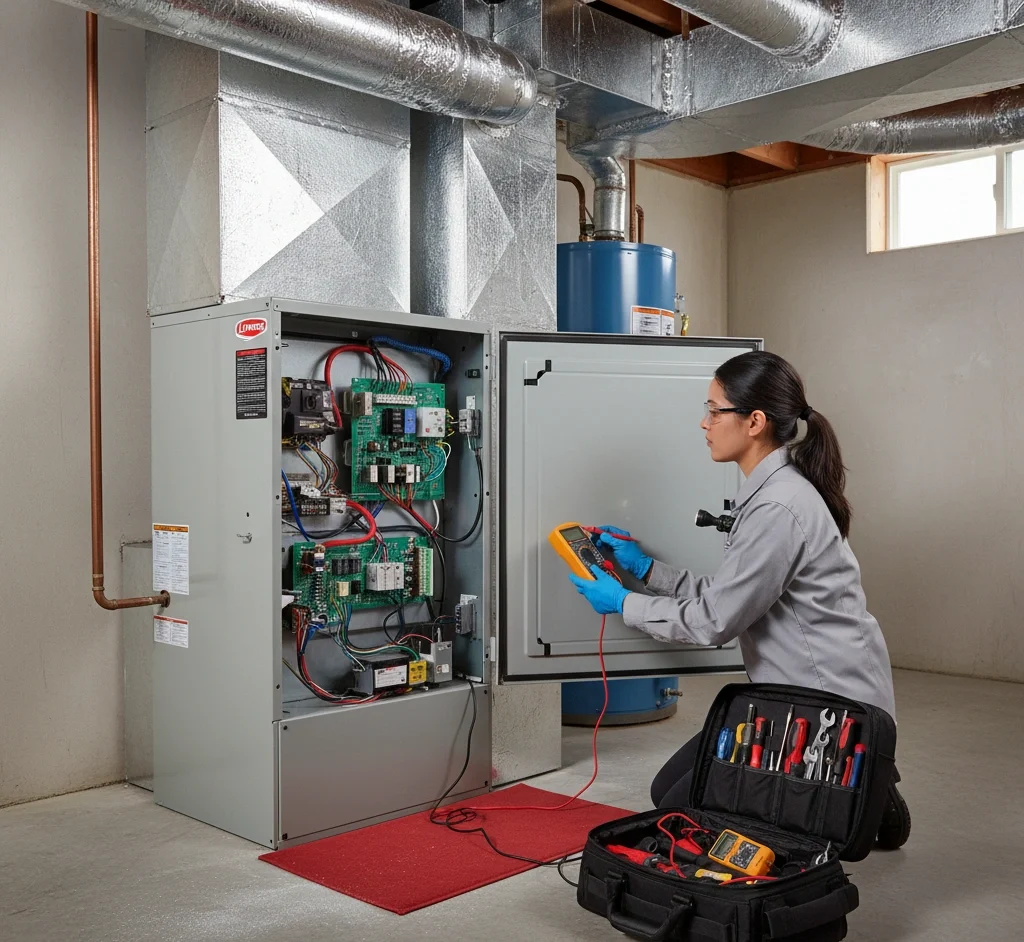Your Ultimate Fall Furnace Maintenance Checklist

These are crucial tasks any homeowner can perform to prepare their heating system for winter. Taking the time to go through these steps can significantly improve your furnace’s efficiency, prevent common problems, and ensure your home is ready for the cold season ahead.
1. Replace Your Air Filter: The Lungs of Your Home
This is the single most important task for the health of your HVAC system. Think of the filter as the lungs of your home—if it can’t breathe, nothing else works correctly. A clogged filter forces your furnace to work much harder, leading to skyrocketing energy bills, poor air quality, and even expensive damage to the blower motor.
How-To Guide:
-
Safety First: Turn off the power to your furnace. There is usually a switch that looks like a light switch on or near the unit. For extra safety, you can also turn it off at your home’s main breaker panel.
-
Locate & Remove: Find the filter compartment, which is a slot located between the main furnace cabinet and the large return air duct. Slide the old, dirty filter out.
-
Check the Size: On the cardboard frame of the filter, you will see its dimensions printed (e.g., 16x25x1). Write this number down or take a picture with your phone.
-
Install the New Filter: Slide the new filter into the slot. Pay close attention to the airflow arrows printed on the frame. These arrows must point towards the furnace, not away from it. This ensures the filter captures debris correctly.
-
Document and Finish: Use a marker to write today’s date on the new filter’s frame. This is a simple trick to help you remember when you last changed it. Now you can restore power to the unit.
2. Clear the Area Around Your Furnace: Create a Safe Zone
Your furnace needs a specific amount of air for proper combustion and ventilation. When the area around it is cluttered, it can starve the system of the air it needs to run safely and efficiently. More importantly, storing items near the furnace, especially flammable ones, is a major fire hazard.
How-To Guide:
-
Establish Clearance: Ensure there is at least 2-3 feet (about 1 meter) of clear space on all sides of the furnace.
-
Remove Hazardous Materials: Never store items like paint cans, gasoline, cleaning supplies, or kitty litter boxes near your furnace. The fumes can be drawn into the system and, in the case of ammonia from kitty litter, can even corrode the unit’s components.
-
Clear the Clutter: Remove any storage boxes, laundry baskets, or other items that could block airflow or become a fire risk.
-
Clean the Exterior: Gently vacuum dust and debris from the floor around the unit. You can also use a damp cloth to wipe down the exterior cabinet of the furnace, but do not attempt to clean the internal components.
3. Unblock All Vents and Registers: Ensure Proper Airflow
Your furnace is designed to heat your entire home using a balanced system of airflow. When vents are blocked, it creates back-pressure that strains the blower motor, leads to uncomfortable hot and cold spots in the house, and can cause the furnace to overheat and shut down.
How-To Guide:
-
Do a “Vent Walkthrough”: Go through every room in your house and visually inspect all air vents. This includes the smaller supply vents that blow warm air out (often on the floor or low on walls) and the larger return vents that pull air back to the furnace (usually on walls or ceilings).
-
Move Obstructions: Make sure none of the vents are covered by furniture, rugs, drapes, toys, or anything else.
-
Keep Vents Open: Resist the common myth that closing vents in unused rooms saves money. For most modern HVAC systems, this actually harms efficiency and can damage your system. It’s best to keep all vents open.
4. Test Your Thermostat: The Brain of the Operation
The thermostat is the control center for your entire heating system. Performing a simple test now ensures it’s communicating correctly with the furnace, which can save you from a no-heat emergency call on the first truly cold night.
How-To Guide:
-
Check the Batteries: If you have a digital thermostat, start by replacing the batteries if they are more than a year old. Weak batteries are a common cause of thermostat issues.
-
Set to “Heat”: Switch the system mode from “Cool” or “Off” to “Heat”. Also, ensure the fan is set to “Auto”, not “On.”
-
Turn Up the Temperature: Set the target temperature about 5 degrees higher than the current room temperature.
-
Listen and Wait: You should hear a soft “click” from the thermostat, followed shortly by the sound of your furnace fan and burners igniting.
-
Confirm Warm Air: Within a few minutes, you should feel warm air coming from your supply vents. If you complete these steps and the furnace doesn’t turn on, it’s time to call a professional for a diagnosis.
Services
About
Copyright © 2025 Kamboj Heating & cooling Inc. | All Rights Reserved.
Design & Deployed By Cosmic Crafty
